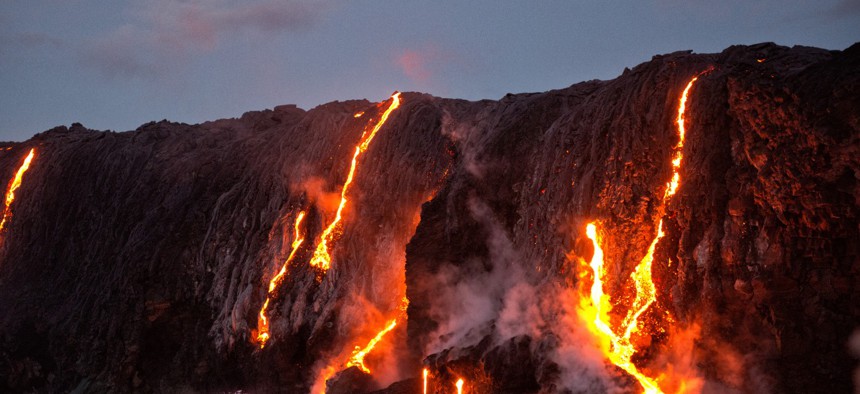
Lava from Kilauea volcano entering ocean, Big Island, Hawaii. theartist312 / istock
The Environmental Threat More Immediate Than Climate Change
The uptick in earthquakes and volcanic eruptions poses substantial dangers for people and the economy, says an EPA scientist.
A Pew Research Center survey conducted last year found that 60% of U.S. adults surveyed viewed climate change as a major threat, and 65% claimed that the federal government was not doing enough to reduce the effects of climate change.
One of the primary endeavors of the Biden administration has been to refocus on climate change, an issue highlighted during the Obama administration. Leading the charge is Michael S. Regan, a former EPA staffer and former head secretary of North Carolina’s Department of Environmental Quality, who recently became the first African American to serve as EPA’s 16th administrator. After a smooth Senate confirmation, Regan quickly announced that “climate change is back” and “front and center” at EPA.
While efforts to combat climate change are debated, sound science must be the foundation for any future climate change action combined with the use of technology to reduce our carbon footprint in all sectors of industry and society. That debate must include the reexamination of scientifically measured carbon that is actually in our atmosphere, land, and oceans, and how much carbon we, as humans, actually generate. More importantly, can we actually stop or limit the generation of gigatons of carbon from greenhouse gases—some of which occurs naturally—to such a degree as to have a significant effect on climate change and global warming? In other words, through currently available technology like carbon capture and sequestration, can we actually mirror the natural global carbon cycle absorption processes of the atmosphere, land, and ocean to such a degree as to have a significant impact on reducing carbon?
The answer to this complex climate carbon conundrum cannot be fully resolved within the term limits of one or two presidential administrations. Climate change is a long-term threat that can only be addressed with a massive reduction in our carbon footprint and advanced alternative energy production on a grand scale. Also needed is an influx of funding and enthusiasm from every economic sector and country across the globe.
A more immediate short-term environmental threat is not climate change, but earth change, as demonstrated by an uptick in earthquakes and volcanic eruptions affecting increasing numbers of people.
According to the U.S. Geological Survey, in the United States, 18 volcanoes are rated at very high risk to include the underground Yellowstone National Park volcanic system, which experiences steam explosions and seismic activity threatening almost 4 million annual visitors. On May 18, 1980, the deadliest and most destructive volcanic eruption in U.S. history occurred at Mount St. Helens near Portland, Oregon. This massive eruption killed 57 people, destroyed hundreds of homes, miles of railways and highways and triggered a 5.1 magnitude earthquake. More recent eruptions of the Kilauea volcano in Hawaii have forced the evacuation of thousands, destroying homes and roadways.
The second major earth change event is earthquakes. Most Americans associate earthquakes with the West Coast, the Pacific Northwest and Alaska, part of the “Ring of Fire”—a horseshoe-shaped region around the Pacific rim with a history of volcanic eruptions and earthquakes. Other parts of the country are also in danger of earthquake activity, according to USGS, with 39 out of the 50 states, including New York and Tennessee, that have moderate to high seismic hazard risk. USGS has further reported that California currently is at risk for an 8.0 magnitude earthquake.
One area of the country that shows alarming earthquake potential is near the “New Madrid” fault in the Southern and Midwestern United States. An earthquake along this fault could impact 15 million people in eight states. USGS reports that 1 million people living in and around Memphis are at the greatest risk of a major earthquake—magnitude 7.0 or 8.0. USGS has reported myriad small short-lived earthquakes across the country called “earthquake swarms” and is analyzing them as potential precursors to a major earthquake.
Federal agencies like USGS have taken steps in earth change threat awareness and assessments, but more needs to be done quickly. One first step is the completion of localized worse-case scenarios to examine infrastructure such as industrial plants, refineries, buildings, bridges, roadways, and railways. Real-time monitoring and alert systems combined with smart technology detection systems need to be placed strategically based on these scenarios.
With Congress considering trillions in infrastructure funding, the focus on earth change should be a top priority and targeted to address this immediate and dangerous environmental threat within the United States.
Anthony Robledo IV has served as an environmental scientist at EPA for over 30 years. He retired from the U.S. Army Reserve as a Lieutenant Colonel, serving as an environmental science officer, and is currently an adjunct instructor at the University of Texas at Arlington Environmental Training Institute.






